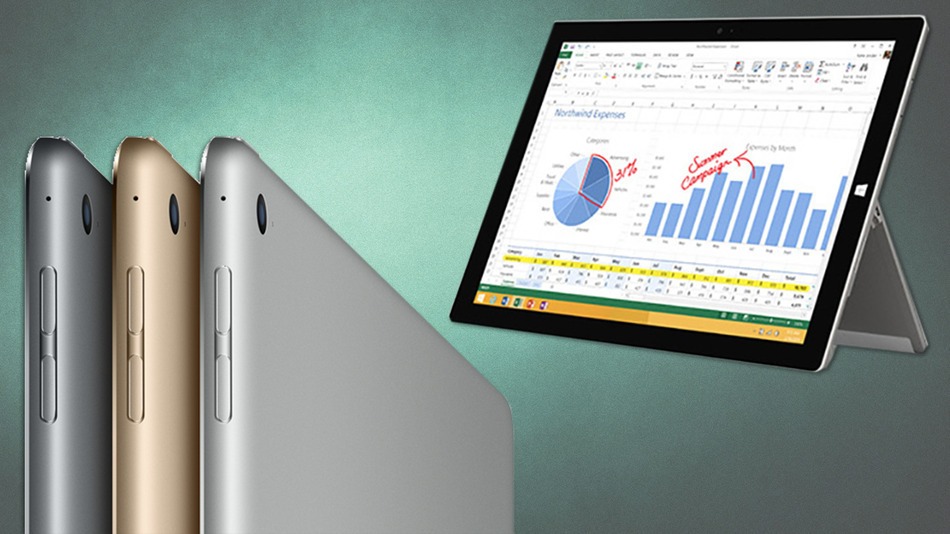The Surface Pro 4 and the iPad Pro are meant to save the PC industry, not the tablet market.
Only ten years ago, the idea of a tablet taking over the workload of a PC, was equal to the concept of bringing a knife to a gunfight. In 2012, Microsoft made its first attempt at building its first personal computer ever, to be completely designed, and manufactured, in-house, under the supervision of former CEO Steve Ballmer.

How are the Surface Pro 4, and iPad Pro saving the PC market
Ballmer’s original ideas for the Surface tablet was based on decent hardware, but the software part was all wrong, and that’s what lead Ballmer to his demise as CEO, as well as a $900 million production surplus write-down on the original Surface RT, which is just the type of thing that doesn’t typically go down well with the board of directors at Microsoft.
Ironically, that initial blunder was destined to start a revolution that only in 2015, with the release of Windows 10, began to make sense in the eyes of consumers, and investors, prompting Microsoft’s new CEO to build upon a concept that is set to save the PC market... with a little help from Apple, of all companies.
The inception of the Pro version of the iPad, indicates Apple’s strong interest in bringing netbook/laptop PC functionality to iPad owners, both on the hardware front, and with iOS improvements leveraging the tablet’s features and capability for power-users. The focus on the iPad Pro as a business device, created to compete with “the majority of laptop PCs”, means that the PC market is actually weak enough for Apple to make a dent in it with an iPad.
This is an important indication that something about the PC market needs to change, and the PC must become a more flexible, multidimensional device, even at the cost of shedding its traditional form factor, for a less conventional one.
The increasing migration of productivity apps to mobile, tells at least one side of the story behind this struggling PC market. Yet, the “mobile revolution” can’t be blamed for that that the PC market has gone through. Consumers want mobility, but they also want a full-size keyboard, and displays big enough to be comfortable doing more than just typing documents.
Banking, paying bills, reading the news, and working on collaborative research papers for school, are few examples of the things for which mobile platforms, like small tablets and smartphones, still have a way to go. Consumers want to play games as well, and not just casual games like puzzles. Full-screen, 3D, GPU accelerated games, like Fallout 4, or Tom Clancy’s The Division, are what gamers want to play, on devices that need to be also portable.
This is where the Surface Pro 4 comes in, doing a wonderful job. Games like Fallout 4, for instance, are especially optimized to take advantage of hardware resources, and to deliver the best possible gaming performance. On a Surface Pro 4, the visuals are stunning, and the framerate is nearly flawless, as shown in one of the many YouTube videos published after the release of Bethesda’s second take on the Fallout franchise.
The dawn of Windows 10 hybrid tablet PCs is here, and it’s most definitely hitting a sweet spot with consumers who can finally have portability and performance, rolled into one device.
Does the tablet need saving?
Tablets, in their purest forms, have not changed much, since they rely on operating systems 100% based on apps, and optimized for use with each particular tablet, whether it’s an iPad or any number of Android tablets available. The truth of the matter is that the iPad is such a staple, for tablet owners, that it’s hard to imagine any other tablet doing what the iPad does. This explains why the iPad’s primary improvement over the years has been faster processors, more storage, and an increasingly thin form factor.
In this respect, the iPad Pro belongs to a different category. According to many owners of the supersized device, the iPad Pro is most definitely as good as any number of consumer laptops, in the entry-level category, due to the larger screen, and split-view, which allows for two apps to be operated simultaneously.
In reference to the regular iPad, there are reasons to believe the consumers will always want a choice between the iPad Mini and the iPad Air, as the use cases are still plenty, especially in the workplace. At home, are still the big winners, over any other tablet on the market. By this token, the tablet market isn’t doing as bad as some may think, and once the hybrid PC reaches its full potential, and become the new standard for consumers, the tablet may very well regain its former appeal, as a companion device.